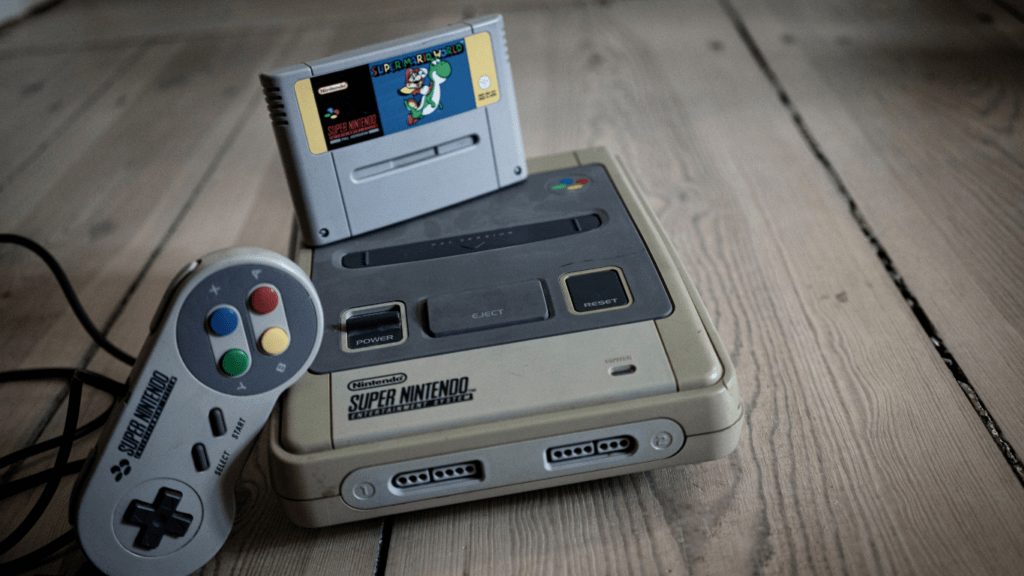The Beginnings of Game Consoles
The initial phase of game consoles laid the groundwork for today’s advanced systems. Exploring the early days, we can see how pioneers transformed simple concepts into a new form of entertainment.
The First Generation
The first generation of game consoles, starting in the early 1970s, introduced basic gaming to households. The Magnavox Odyssey, released in 1972, was the first commercial home video game console.
It used cartridges to switch between games, a revolutionary idea at the time. Players could engage in simple games like tennis and chase, using controllers with dials and buttons.
In 1975, Atari released Pong as a standalone console. Unlike the Odyssey which used multiple games, Pong focused solely on one.
It became immensely popular, setting the stage for future commercial successes in the gaming industry.
Key Innovations and Developers
Key innovations during this era came from groundbreaking developers and companies. Ralph H. Baer, often called the “Father of Video Games,” developed the concepts behind the Magnavox Odyssey.
His visionary ideas provided the blueprint for future consoles.
Atari, co-founded by Nolan Bushnell and Ted Dabney, was a pivotal player. Their development of Pong capitalized on an emerging market.
They later introduced the Atari 2600 in 1977, further advancing the industry with its use of ROM cartridges, a microprocessor, and custom graphics chips.
Early consoles and developers set the stage for a transformative journey in the gaming world.
The Golden Age: Game Consoles of the 80s and 90s

The 80s and 90s marked a transformative era for game consoles, bringing innovations that defined the industry.
This period saw the shift from simple gaming systems to complex, multi-functional entertainment devices.
The Rise of Cartridge-Based Systems
Cartridge-based systems revolutionized gaming in the 80s. Consoles like the Nintendo Entertainment System (NES) and the Sega Genesis used cartridges, offering enhanced graphics and larger game libraries.
Unlike earlier systems where games were built-in, these consoles allowed users to swap games effortlessly. The NES, released in 1985, became a household name, selling over 60 million units worldwide.
Sega’s Genesis, launched in 1989, rivaled the NES, known for its superior processing power and hit titles like Sonic the Hedgehog.
Iconic Games and Game Series
The Golden Age produced numerous iconic games and series that remain influential today. Super Mario Bros., released in 1985, redefined platform games and became a cultural phenomenon.
The Legend of Zelda series, introduced in 1986, pioneered open-world exploration and deep storytelling.
Sega’s Sonic the Hedgehog, debuting in 1991, featured fast-paced gameplay that distinguished it from competitors.
These titles not only showcased the technical capabilities of their respective consoles but also established enduring franchises that continue to evolve with modern gaming trends.
Modern Gaming Systems
Modern gaming systems have transformed the digital entertainment landscape, pushing the boundaries of graphics, connectivity, and interactivity.
These advancements have redefined user experiences both on and offline.
The Shift to Digital and Online Gaming
The shift to digital and online gaming has revolutionized how we access and play games.
Game consoles now come equipped with internet connectivity, enabling players to download games directly, eliminating the need for physical media.
Steam, Xbox Live, and PlayStation Network exemplify platforms offering vast digital game libraries with features like cloud saves and user reviews.
Online multiplayer games have gained global popularity.
Titles like:
- Fortnite
- Call of Duty: Warzone
- Apex Legends
showcase this trend, letting gamers worldwide compete and collaborate in real-time.
Cloud gaming services like Google Stadia and NVIDIA GeForce Now further enhance accessibility, allowing high-quality gaming without powerful local hardware.
Subscription services, including Xbox Game Pass and PlayStation Plus, offer access to extensive game libraries for a monthly fee. This model encourages continuous engagement and provides immediate access to new releases and classic titles.
Leading Brands and Their Flagship Models
Leading brands in the gaming industry have set benchmarks with their flagship models.
- Sony’s PlayStation 5, launched in November 2020, boasts a custom SSD for rapid loading, ray tracing for stunning visuals, and exclusive titles like Demon’s Souls and Ratchet & Clank: Rift Apart.
- Microsoft’s Xbox Series X, also released in November 2020, features the powerful 12 teraflop GPU, quick resume functionality, and extensive backward compatibility.
- Xbox Game Pass enhances the platform, offering a diverse game catalog.
- Nintendo remains a pivotal player with its innovative Switch console.
Released in March 2017, the hybrid design allows seamless transitions between handheld and docked modes. - The Switch’s unique approach has resulted in an extensive library of first-party titles like The Legend of Zelda: Breath of the Wild and Animal Crossing: New Horizons, blending portability with quality.
These brands continuously push technological boundaries, shaping the future of gaming with each new generation of consoles.
Their innovations highlight the ongoing evolution and competitive nature of the gaming industry.
The Future of Game Consoles
Game consoles continue to evolve, driven by rapid technological advancements and changing consumer preferences.
This section examines potential future developments in game consoles and how they might change the industry.
Predictions on Technology and User Experience
- Future consoles may significantly enhance user experiences with new technologies.
- I expect greater focus on virtual reality (VR) and augmented reality (AR) due to their immersive capabilities.
- Major gaming companies have already invested in VR, with Sony’s PlayStation VR and Facebook’s Oculus Quest leading the charge.
- Experts predict these technologies will become more sophisticated and widespread.
- Artificial intelligence (AI) will likely play a more prominent role.
- Developers might use AI to create more realistic non-player characters (NPCs) and dynamic game environments, adapting gameplay based on user behavior.
- Ray tracing technology, which enhances graphics by simulating real-life light interactions, could become standard across all future consoles, improving visual realism.
- Cloud gaming will likely grow, reducing the need for physical hardware. Companies like Google (Stadia), Microsoft (xCloud), and NVIDIA (GeForce Now) have already introduced cloud gaming platforms.
- Future consoles may leverage this technology to offer gaming experiences without relying on local hardware’s limitations.
Potential Market Changes
The market might see shifts influenced by new business models and consumer demands. Subscription-based services could become more dominant, akin to Netflix’s impact on movie and TV streaming.
Microsoft Game Pass and PlayStation Now suggest this trend, providing access to extensive game libraries for a monthly fee.
Cross-platform play could become a standard feature, driven by the increasing demand for a unified gaming experience across different devices.
Games like Fortnite and Call of Duty: Warzone demonstrate the feasibility and popularity of cross-play, encouraging a more integrated gaming ecosystem.
Sustainability might also influence future console designs. As consumers grow more environmentally conscious, companies may prioritize energy-efficient consoles and sustainable materials.
Efforts to reduce electronic waste through modular design, where users upgrade parts rather than replacing entire systems, could gain traction.
Game consoles’ future hinges on innovation, consumer trends, and market adaptation.
These factors will shape the next generation of gaming experiences, potentially revolutionizing the industry.

 Janets Barnettiero is the dynamic founder of Gamble Guru Gate, a pioneering platform that stands as a beacon of expertise and guidance in the gambling sector. With a career spanning over two decades, Janets has cultivated a deep understanding of the intricacies of the gambling industry, blending her analytical skills with a passion for responsible gambling practices.
Her journey began with a fascination for the mechanics and psychology of gambling, leading her to pursue studies in mathematics and behavioral science. This educational foundation laid the groundwork for her insightful approach to gambling analysis. Early in her career, Janets worked with several top-tier casinos and gaming companies, gaining hands-on experience and insider knowledge that would later fuel the success of Gamble Guru Gate.
Janets Barnettiero is the dynamic founder of Gamble Guru Gate, a pioneering platform that stands as a beacon of expertise and guidance in the gambling sector. With a career spanning over two decades, Janets has cultivated a deep understanding of the intricacies of the gambling industry, blending her analytical skills with a passion for responsible gambling practices.
Her journey began with a fascination for the mechanics and psychology of gambling, leading her to pursue studies in mathematics and behavioral science. This educational foundation laid the groundwork for her insightful approach to gambling analysis. Early in her career, Janets worked with several top-tier casinos and gaming companies, gaining hands-on experience and insider knowledge that would later fuel the success of Gamble Guru Gate.
